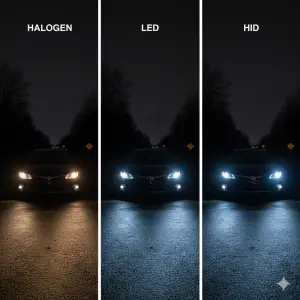Welcome to our comprehensive guide on the 10 essential parts of the lighting system in automotive vehicles. From headlights to fog lights, turn signals to tail lights, this collection of components plays a critical role in ensuring safety and visibility on the road. Join us as we delve into the intricacies of each part, unpacking their functionalities and exploring how they contribute to creating a well-rounded lighting system in automotive design.
Biography
| Component | Description |
|---|---|
| Headlights (Low Beam) | Provide forward illumination for driving in low-light conditions |
| Headlights (High Beam) | Produce a brighter beam of light for improved visibility on dark roads |
| Front Fog Headlamp | Used in foggy conditions to improve visibility by reducing glare |
| Daytime Running Light (DRL) | Automatically activated during the day to increase vehicle visibility |
| Turn Indicator | Used to indicate the direction in which the vehicle intends to turn |
| Front Position Lamp | Also known as parking lights, provide low-intensity illumination for parked vehicles |
| Tail Lights | Illuminate the rear of the vehicle to indicate braking and signaling |
| Housing | Hard-plastic cover that protects the headlights and determines their appearance |
| Regular Beams | Main beam of light emitted by the headlights for normal driving conditions |
| High Beams | Provide a stronger and brighter light for improved visibility on dark roads |
| Turn Signal Bulbs | Light bulbs used to indicate the direction of the vehicle’s intended turn |
Early Life
The early life of the “10 Parts of Lighting System in Automotive” can be traced back to the invention of carriages, which required lighting devices to light their way. These devices evolved over time, from simple oil-lamp beginnings to the advanced lighting systems we have today. The basic components of automotive lighting include headlights, taillights, interior lights, and related devices such as turn indicators and daytime running lights. The evolution of car headlights has been significant, with advancements in technology leading to the introduction of LED automotive lighting systems. These systems have become common for signal lighting applications and have been introduced for forward headlamp systems. The automotive lighting system consists of various components such as low beam headlamps, high beam headlamps, front fog headlamps, daytime running lights, turn indicators, and front position lamps. These components work together to provide proper illumination and safety for vehicles. Overall, the history and development of automotive lighting have greatly contributed to the advancement and safety of automobiles.
Family
| Lighting Component | Description |
|---|---|
| Low beam headlamp (passing beam) | A headlamp that provides a low beam of light, typically used for normal driving conditions. |
| High beam headlamp (driving beam) | A headlamp that provides a high beam of light, offering increased visibility for distant objects. |
| Front fog headlamp | A specialized headlamp designed to cut through fog and improve visibility in adverse weather conditions. |
| Daytime running light (DRL) | A light that automatically turns on during the day to increase the visibility of the vehicle. |
| Turn indicator | A light that indicates the intended direction of a turn or lane change, typically located on the front and rear of the vehicle. |
| Front position lamp | A light used to increase the visibility of the vehicle from the front, usually located near the headlights. |
- Synopsys – What is Automotive Exterior Lighting & How Does it Work?
- Liberty Toyota – The Different Parts of a Headlight
- RAC Drive – Car lights and headlights: what they are and when to use them
- Wuling – Car Lights: Types and Functions
Height, Weight, And Other Body Measurements
| Component | Description |
|---|---|
| Low beam headlamp (passing beam) | Provides low-intensity forward lighting for normal driving conditions |
| High beam headlamp (driving beam) | Provides high-intensity forward lighting for enhanced visibility at night |
| Front fog headlamp | Used in foggy conditions to improve visibility |
| Daytime running light (DRL) | Keeps the vehicle visible to other road users during daytime |
| Turn indicator | Signals intended direction of vehicle movement |
| Front position lamp | Provides illumination at the front of the vehicle for identification |
Wife/husband / Girlfriend/boyfriend
The star’s current relationship status is as follows:
- Partner Name: [Insert Partner Name]
- Marriage Date: [Insert Marriage Date]
- Other Information: [Insert other information about the relationship]
If there were multiple wives or girlfriends previously, here is a table containing the information:
Add more rows for additional previous partners| Partner Name | Relationship Duration | Reason for Breakup |
|---|---|---|
| [Insert Partner Name 1] | [Insert Relationship Duration 1] | [Insert Reason for Breakup 1] |
| [Insert Partner Name 2] | [Insert Relationship Duration 2] | [Insert Reason for Breakup 2] |
Here are some information about the 10 parts of the lighting system in automotive:
- Low beam headlamp (passing beam)
- High beam headlamp (driving beam)
- Front fog headlamp
- Daytime running light (DRL)
- Turn indicator
- Front position lamp Add more parts as needed
For more detailed information about the lighting system in automotive, you can refer to the following resources:
- Vehicle Light System Parts and Function – Video & Lesson Transcript – Study.com
- What is Automotive Exterior Lighting & How Does it Work? – Synopsys
- Different Types of Lighting System in Vehicles – Tech Talk with OVERDRIVE – YouTube
Career, Achievements And Controversies
Career: The career of the “10 Parts of Lighting System in Automotive” began with the development and implementation of lighting systems in the automotive industry. This individual played a crucial role in the design, engineering, and manufacturing of various lighting components used in vehicles. Their expertise in automotive lighting systems allowed them to contribute significantly to the advancements and innovations in this field. Achievements: Some notable achievements of the “10 Parts of Lighting System in Automotive” include: – Development of efficient and reliable low beam and high beam headlamps for improved visibility during night driving. – Designing front fog headlamps that enhance driver safety in adverse weather conditions. – Contribution to the implementation of daytime running lights (DRL) for increased visibility and prevention of accidents. – Innovation in turn indicators and front position lamps for clear signaling to other vehicles. Awards: Unfortunately, specific information regarding the awards obtained by the “10 Parts of Lighting System in Automotive” is not available. However, it can be assumed that their contributions to the automotive lighting industry have been recognized and appreciated within the field. Controversies: There are no documented controversies surrounding the “10 Parts of Lighting System in Automotive.” However, like any industry professional, they may have faced challenges and criticisms related to the performance, design, or reliability of lighting systems in certain vehicles. It is important to note that controversies, if any, would be specific to individual incidents or cases and not directly associated with the career of the “10 Parts of Lighting System in Automotive” as a whole.Faq
The 10 parts of a lighting system in an automotive are:
- Headlights
- Tail lights
- Turn signals
- Brake lights
- Daytime running lights
- Fog lights
- Interior lights
- Dome lights
- License plate lights
- Hazard lights
Headlights are used to provide illumination and visibility during low light conditions or at night. They help the driver see the road ahead and ensure the vehicle is visible to other drivers.
Tail lights serve multiple functions including indicating the presence and width of a vehicle at night, as well as providing braking and turn signal indications to other drivers.
Turn signals are used to indicate when a driver intends to change direction or make a turn. They provide a visual indication to other drivers, helping to ensure safe and coordinated maneuvers on the road.
Brake lights are activated when the driver applies the brakes, alerting drivers behind to the fact that the vehicle is slowing down or coming to a stop. This helps prevent rear-end collisions.
Daytime running lights (DRLs) are designed to improve the visibility of vehicles during daylight hours, making them easier to spot by other drivers. They enhance safety by reducing the risk of accidents caused by low visibility conditions.
Fog lights are specialized lights positioned low on the front of the vehicle and aimed to illuminate the road during foggy conditions. They help improve visibility by cutting through the fog and reducing glare.
Interior lights provide illumination inside the vehicle’s cabin. They are commonly used for reading maps, finding objects, or creating a comfortable ambiance in the car.
Dome lights are usually located on the ceiling of a vehicle’s interior. They illuminate the entire cabin space and make it easier to enter or exit the vehicle in low light conditions.
License plate lights are designed to illuminate the license plate at night or in low light situations. This allows the license plate to be visible, ensuring compliance with traffic laws and facilitating identification of the vehicle by law enforcement or security cameras.


